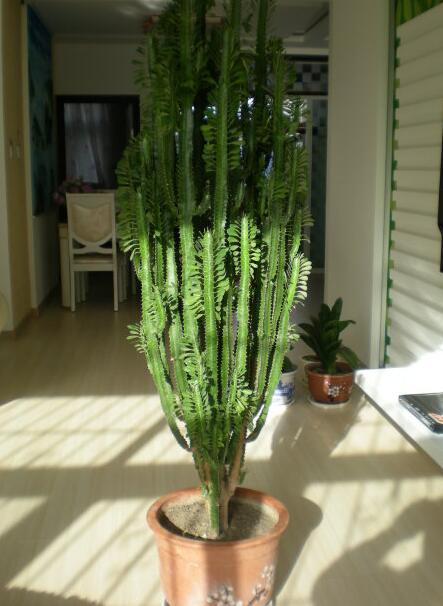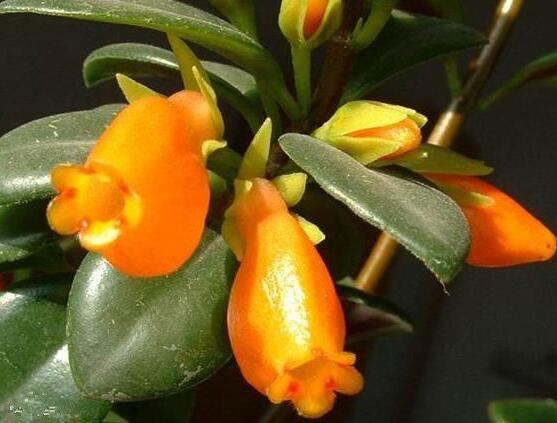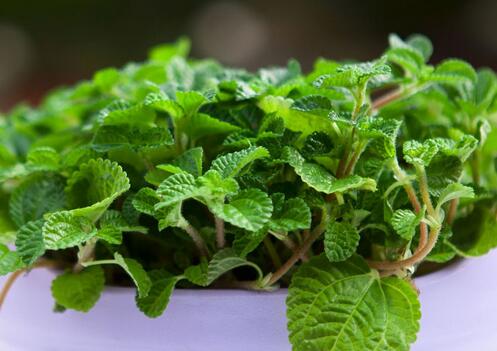Culture methods and matters needing attention of keel flower the most suitable home plant
The dragon bone flower likes warmth and the air is warm. It should be semi-overcast and the plants will turn yellow in the strong direct sunlight. The suitable temperature for growth is 25 ~ 35 ℃. It is sensitive to low temperature, and the stem nodes are easy to rot under the condition of less than 5 ℃. Like the fertile loam with more humus, the pot soil can be prepared with the same amount of rotten leaves, coarse sand and mature barnyard manure. The following editor brings the breeding methods and matters needing attention of keel flower for your reference.

The culture method of keel flower:
Planting
Like loose, fertile, humus-rich soil. Pot soil can be mixed with 1 part of rotten leaf soil and 1 part of coarse sand and mixed with a small amount of mature chicken manure or cow manure.
Light
Light and temperature should be maintained in a semi-overcast environment in summer. In winter, sufficient light is required, put in the sunny place indoors, the temperature should be kept above 10 ℃, and freezing injury is easy to occur when the temperature is lower than 10 ℃.
Fertilizer application
Water application and fertilization should not be too much in spring, watering should be done every 10-15 days, but water should be sprayed to the plant every day to increase air humidity. It should be watered once a day in summer, preferably in the morning or evening. The basin soil should be kept moderately dry in winter, and plastic film can be used to cover the basin to protect the overwintering. The overwintering cultivation environment should maintain both high temperature and high air humidity.
Administration and Management
For planting Bawanhua, you can make use of its good climbing characteristics to choose wasteland that is not suitable for planting other crops or the walls and trees behind the house, or to build a high border or brick wall with a height of 1.5 to 2 meters and a width of 30 centimeters in the field. it can also be cultivated with bamboo poles or cement columns. The overlord flower is generally not strong. Choose more than one-year-old meat stem, cut into 20-30 cm section obliquely inserted into the soil, asexual reproduction. Cutting can be carried out in all seasons of the year, and the planting density is 10 × 100 cm. Water frequently after cutting to keep the soil moist, promote adventitious root growth and promote living development. Some of the plants cut in spring can blossom in winter of the same year, but they are not sold as commodities. After entering the flowering stage in the second year, the growth-promoting fertilizer to promote the germination of new seedlings should be applied from January to February, the body-strengthening fertilizer to promote stem growth from March to April, the flower bud fertilizer to promote flower growth from May to June, and the fitness fertilizer to restore physical strength twice according to the plant growth during the picking period. Topdressing should apply rotten organic fertilizer as far as possible. If chemical fertilizer is used, total nutrient mixed fertilizer should be selected. The third year is the year in which the overlord flower enters its peak growth period. In order to prevent premature senescence and maintain the vitality of the base, pruning should be carried out in addition to reasonable fertilization.
Pruning
First, cut off the old branches that rarely blossom.
Second, make use of the advantage of exuberant new buds and more blossoms at the top to remove the weak buds growing below, so that the apical buds can fully develop and elongate, and give full play to the apical advantage. Bawang flower blossoms from May to November, about 7-8 stages, with an interval of about 20 days. The size of the flower is 25-30 days after budding. At this time, it is also the best harvest time. The best harvest time is the morning or afternoon after blooming. The flowers on the market and for export are dried flowers processed. (fortune-teller www.azg168.com)
Storage and processing
The cuttings actually use the fleshy stem of the plant, and it is relatively easy to manage postharvest because it is so drought-resistant that it is usually harmless to leave it in the air for days or even tens of days. Usually, the fleshy stems can be cut at the stem nodes, then pre-cooled, graded, and then bundled into the box for every 10 bunches. Immediately store the processed cuttings in an environment with a relative humidity of 70% / 80% and a temperature of 4 / 6 ℃. Cuttings can usually be stored for 7 days and 10 days under the above conditions without affecting the effect of use. The packaging materials are usually packed in 60cm × 45cm × 30cm lined tile cartons. Pay attention to the lining film, tile edge carton should be provided with air holes. # p# subtitle # e #
Matters needing attention in the culture of keel flower:
The keel likes a warm and humid environment, and the plants turn yellow in direct sunlight. Able to withstand drought, afraid of low temperature and frost, the suitable temperature for growth is 25-35 ℃, and the winter overwintering temperature should not be lower than 7 ℃, otherwise it is easy to suffer frost damage and stem nodes are easy to rot. When cultivating, we should pay attention to the following points:
1. Planting: keel is easy to survive and likes sandy soil rich in humus. If it is difficult to find this kind of sandy soil, you can find some softer soil at will. The keel is not too demanding on the soil, and the general soil can feed it.
2, light and temperature: because the keel yellowed under the strong direct sunlight, it should be maintained in semi-overcast environment in summer, while in winter, it should be kept in the sunny place indoors, the temperature should be kept above 10 ℃, and the basin should be turned at regular intervals. In winter, the keel can not be raised indoors in the north, and it is easy to be frostbitten to death.
3. Maintenance: keel flower is resistant to drought and should be watered properly. Water can be watered every five days in summer, if the basin soil is too wet for a long time, it will cause rotten roots. Watering water once a month during the winter dormancy period will not dry to death.
4. Fertilization: in order to make it grow well, nitrogen fertilizer is applied once a month during the growth period, and it is better to use self-made fertilizer. After crushing soybeans or peanuts, they can be buried in flowerpots, or soaked and rotten, and then buried in the soil for fertilization. But the use of fertilizer should not be too thick, so as not to cause fertilizer damage and lead to rotting roots. Keel. PNG
5. Propagation: keel is propagated by cutting. Cut more than 10 cm of branches, wash the slurry, and then cut it 12 hours after drying. (or direct cutting can survive after cutting, but the survival rate is slightly lower.) A week later, when the new keel begins to lose water and wilt, a small amount of water is watered, sand rather than wet, so as not to rot the cut. Just put it in a semi-shade, it's easy to take root.
The function of keel column
Each kind of different plant plays a different role in home decoration. Today, I will take you to understand the role of keel pillar in home center and breeding methods!
1, keel column brief introduction keel column, also known as keel, plant triangular shape, multi-branched, blue-green, 4 meters to 5 meters high, edges with small thorns, very short. Keel column summer white flowers, 4 to 9, clustered on the upper thorn seat, day open and night closed (potted plants are generally not easy to bloom), berries small round, blue-purple, edible. 2. The culture method of keel column keel likes warm and humid environment, and the plant turns yellow in direct sunlight. Able to withstand drought, afraid of low temperature and frost, the suitable temperature for growth is 25-35 ℃, and the winter overwintering temperature should not be lower than 7 ℃, otherwise it is easy to suffer frost damage and stem nodes are easy to rot. Cultivation should pay attention to a few points: 1, planting: keel is very easy to survive, like rich in humus-rich sandy soil. If it is difficult to find this kind of sandy soil, you can find some softer soil at will. The keel is not too demanding on the soil, and the general soil can feed it. 2, light and temperature: because the keel yellowed under the strong direct sunlight, it should be maintained in semi-overcast environment in summer, while in winter, it should be kept in the sunny place indoors, the temperature should be kept above 10 ℃, and the basin should be turned at regular intervals. In winter, the keel can not be raised indoors in the north, and it is easy to be frostbitten to death. 3. Maintenance: keel flower is resistant to drought and should be watered properly. Water can be watered every five days in summer, if the basin soil is too wet for a long time, it will cause rotten roots. Watering water once a month during the winter dormancy period will not dry to death. 4. Fertilization: in order to make it grow well, nitrogen fertilizer is applied once a month during the growth period, and it is better to use self-made fertilizer. After crushing soybeans or peanuts, they can be buried in flowerpots, or soaked and rotten, and then buried in the soil for fertilization. But the use of fertilizer should not be too thick, so as not to cause fertilizer damage and lead to rotting roots. 5. Propagation: keel is propagated by cutting. Cut more than 10 cm of branches, wash the slurry, and then cut it 12 hours after drying. (or direct cutting can survive after cutting, but the survival rate is slightly lower.) A week later, when the new keel begins to lose water and wilt, a small amount of water is watered, sand rather than wet, so as not to rot the cut. Just put it in a semi-shade, it's easy to take root. 6. Management: the keel grows fast and is easy to breed, and its management requirements are not strict. You can keep branches or pruning as you like, but each pruning should not be too long. It is best to wait for the keel to grow to more than half a meter before it can be trimmed.
3. The collocation of keel column and household style
Keel column is a succulent plant, in the home collocation can not be placed at will, need to pay attention to its location to avoid committing a fengshui taboo. 1. Among the succulent plants, the cactus is a fengshui plant, which should not be placed at the entrance and exit of the gate. Sharp plants contain tit-for-tat, tongues of right and wrong meaning, try not to place. 2. There is evil spirit under the crossbeam, but this kind of evil spirit is pressed down, so it is not suitable to use thorny plants, so it is necessary to choose non-prickly varieties in the display of succulent plants, such as crassulaceae, osmanthus, and so on. 3. Do not put succulent plants in the bedroom, which are prone to allergic reactions to skin and mucous membrane cells. Succulent plants are common in home furnishings and are easy to feed, but pay attention to the problem of fengshui and put them in the right place.
4. Fengshui application of keel column
Dragon, an animal in Chinese folklore, can call the wind and rain and turn the river upside down. It has been regarded as a symbol of auspiciousness since ancient times. Fengshui refers to the mountain as the dragon, the soil as the dragon, the stone as the keel, the vegetation as the dragon scale, and the continuous direction of the mountain as the dragon vein. According to fengshui, the shape of the keel column is very unique, and the stem grows tall and straight upward, resembling an upright keel, full of strength, and has a strong resistance to the outside, and the short thorns on the stem can rush to the top of bad luck, so the keel is a good plant that can transform the evil spirit into a mansion. For a long time, keels have been planted in front and behind houses in some parts of the south.
5. The role of keel column in the center of home.
Ornamental value keel column is varied, there are cluster-shaped, three-column, nine-column and so on. The author thinks that the nine-column and twelve-column shape are spectacular, and the specific methods of plastic surgery are as follows: when the nine-column plant grows to 20 cm to 30 cm, the top is cut off with a sharp knife and immediately sealed with plant ash, and after the plant grows into branches, only the three branches at the top are retained, requiring one for each corner and erasing the rest. When the second layer grows to 25 cm to 30 cm, the top is cut off, and three branches are still selected after the branches are born, three per corner, that is, 1, 3, 9-shaped keels. The method of twelve-column angle selection is the same as above, except that when the 9-column grows to 20 cm to 30 cm, the top is cut off and three branches are cultivated, one or three for each corner. The rest of the small branches are erased as they grow, keeping the shape of the tree consistent. When the cluster columnar plant grows to 40 cm to 50 cm or 30 cm to 40 cm, the top is cut off to let it grow naturally to form a polycephalic keel, but the selection should be orderly and should not be disordered. Keel column growth height of 2 meters to 3 meters, the formation of a large number of branches, easy to cause top-heavy and unstable, so should be fixed with sticks in time. The keel column needs plenty of sunshine, the branches are blue-green, the leaves are like fish scales, and they sparkle in the sun, with numerous bodies and sharp swords, which are spectacular and are good for potted flowers. The value of life in the application of home, in addition to the role of evil spirits, but also has a good purification effect, for the newly renovated family and office buildings between the house, formaldehyde, benzene, radon, ammonia, TVOC has a good adsorption effect.
- Prev

Why did the goldfish hanging orchid lose its leaves? what should I do?
Fish hanging orchid is a kind of herb which is suitable for viewing leaves and flowers. Its leaves are green and look very pleasing to the eye, but sometimes people will find that it keeps dropping leaves, so why do goldfish hanging orchids lose their leaves? What if the leaves fall off? Why did the goldfish hanging orchid lose its leaves: 1. Put it in the wrong place.
- Next

How to breed and breed drug-addicted grass and matters needing attention
Drug addicts are common indoor plants, which can absorb indoor harmful gases, purify the air, beautify the environment, reduce pollution and protect eyes. So how do drug weeds breed? The following editor will bring you the details.
Related
- Fuxing push coffee new agricultural production and marketing class: lack of small-scale processing plants
- Jujube rice field leisure farm deep ploughing Yilan for five years to create a space for organic food and play
- Nongyu Farm-A trial of organic papaya for brave women with advanced technology
- Four points for attention in the prevention and control of diseases and insect pests of edible fungi
- How to add nutrient solution to Edible Fungi
- Is there any good way to control edible fungus mites?
- Open Inoculation Technology of Edible Fungi
- Is there any clever way to use fertilizer for edible fungus in winter?
- What agents are used to kill the pathogens of edible fungi in the mushroom shed?
- Rapid drying of Edible Fungi

